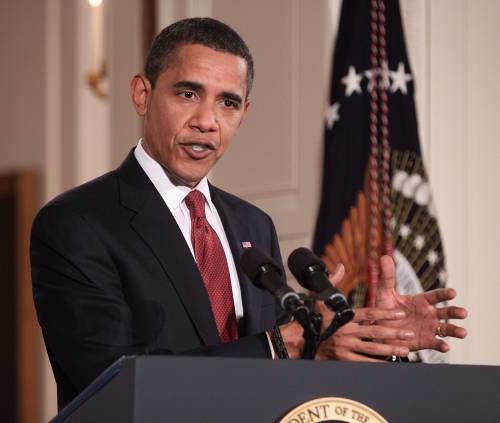White House Silence Paved Way for ‘Cramdown’ Crash
A central component of the Obama administration’s economic strategy was abandoned by the White House in the days leading up Senate vote, giving political cover to opposing Democrats.
Jul 31, 2020108.3K Shares1.6M Views
President Barack Obama (WDCpix)
Though mortgage bankruptcy reform has been a central component of the Obama administration’s foreclosure prevention strategy, the White House all but abandoned the proposal in the days leading up to last week’s Senate vote, providing some Democrats with the political cover to kill the bill and leaving supporters scratching their heads in wonder why the administration didn’t push harder for passage.
The proposal, sponsored by Sen. Richard Durbin (D-Ill.), would have empowered bankruptcy judges to reduce, or “cramdown,” the terms of primary mortgages, allowing some struggling homeowners to avoid foreclosure. Obama supported the measure on the campaign trail last year, and endorsed it again in February as he unveiled his anti-foreclosure plan.
Illustration by: Matt Mahurin
Yet in the days before Thursday’s Senate vote, the silence emanating from the White House was palpable. Unlike Obama’s high-profile supportfor legislation to reformthe credit card industry, the president made no public statements on cramdown, nor did he pressure Democratic lawmakers to support the bill.
“When the time came to stand up to the banking lobbies and cajole yes votes from reluctant senators — the White House didn’t,” The New York Times wrote in a biting editorialMonday.
The administrative hush led some lawmakers to believe the issue was no longer a priority for the White House. Indeed, a spokesperson for Sen. Michael Bennet (D-Colo.) — who opposed the proposal, saying it was too broad and would have raised interest rates — told The Denver Postthat a “no” vote was not inconsistent with Obama’s position.
That sentiment allowed on-the-fence Democrats to oppose the measure without being perceived as defying the White House. Indeed, the measure failed 45 to 51 — 15 votes shy of defeating the GOP filibuster — with 12 Democrats joining every Republican to kill the bill.
The vote arrived at a time when foreclosure rates are skyrocketing and more and more homeowners find themselves “underwater” — owing more on their mortgages than their homes are worth.
In another curious move, the White House issued a statement last week reiterating its support for “appropriately tailored bankruptcy language” as part of its anti-foreclosure strategy. But the statement wasn’t released until a day afterthe Durbin’s cramdown amendment had already failed on the Senate floor.
Administration officials deny that Obama’s support for cramdown ever waned. “The President continues to support balanced bankruptcy reform to permit judicial modifications of mortgages for borrowers who have run out of options and is working with the Congress to get a bill enacted,” White House spokesman Nick Shapiro wrote in an email this week. But asked why Obama chose not to twist arms on the Senate vote, the White House didn’t respond.
Some observers say the administration’s silence simply represents a recognition that the proposal was doomed from the start. “They definitely left it hanging out there,” said a representative of the finance industry, who would only speak anonymously due to the delicate politics surrounding the issue. “But why would you expend political capital on something so many Democrats oppose, and it’s going to lose anyway? That just creates an ugly dinner table mess.”
Observers on all sides of the debate say that the administration made a political calculation, deciding that credit card reform would yield more mileage than cramdown.
“Bankruptcy reform, important as it was, was sort of esoteric,” Sen. Charles Schumer (D-N.Y.), who sponsored Durbin’s bill, told Politico this week. “If you went into O’Halloran’s Pub, the fellas aren’t saying to you, ‘What’s going on with bankruptcy reform?’ But they might say, ‘What are you doing about my credit cards?’”
Yet many experts are quick to point out that it was the housing crisis — not credit card abuses — that led to the global economic meltdown. Unless the housing market stabilizes, they say, the federal spending on bailouts and stimulus measures will be largely undermined.
“They can’t solve [housing] in isolation from the rest of the economy,” said Desmond Lachman, economist at the conservative American Enterprise Institute, “and they can’t solve the rest of the economy without fixing housing.”
Recent figures indicate that “fixing housing” remains a ways away. Foreclosure filings topped 341,000 in March alone — up 17 percent from the month before, according to RealtyTrac, an online foreclosure database. More recently, the realty Website Zillow.com released a studyrevealing that roughly 20.4 million homeowners — representing 20 percent of all homes — were underwater at the end of March, up from 16.3 million three months earlier.
On Tuesday, Federal Reserve Chairman Ben Bernanke delivered more bad news for the housing market, telling a congressional panel that unemployment would likely continue to rise through the remainder of the year.
“There’s no doubt in our minds,” said David Berenbaum, executive vice president of the National Community Reinvestment Coalition, “that the number of foreclosures will go up as unemployment goes up.”
Former chairman and CEO of Honeywell and CNBC financial analyst Larry Bossidy this week predicted 3 million foreclosures this year. “Housing’s still in the dumps,” he said.
Cramdown supporters argue that bankruptcy reforms would provide a last resort that could cut into those numbers. Under current law, consumers may file for bankruptcy to save second homes, boats, cars and almost any other material possession. Primary mortgages, however, are exempted. The Durbin bill would have empowered judges to reduce the principal and the interest rate while increasing the duration of the loan to prevent foreclosure. A similar proposal passed the Housein March.
Last month, Mark Zandi, economist at Moody’s Economy.com, along with the Center for Responsible Lending, issued a report finding that the Durbin amendment would prevent nearly 1.7 million foreclosures — not because 1.7 million homeowners would file for bankruptcy, but because lenders and servicers would be more likely to reduce the terms of mortgage loans voluntarily if threatened with the possibility that a judge might do it instead.
Part of the problem facing cramdown stems from the moral hazard associated with saving homeowners who bought over their heads. “It’s easy to send out a $600 check,” said Campbell Harvey, a finance expert at Duke University, referring to Congress’ first stimulus strategy in early 2008. “To figure out who was a prudent borrower and who was an irresponsible borrower, that’s much tougher to do.”
The finance industry remains adamantly opposed to cramdown, arguing that the uncertainty associated with allowing judges to change mortgage terms would force lenders to pass the risk along to more responsible borrowers in the form of higher rates.
Durbin spokesman Max Gleischman said this week that the issue isn’t dead, but he couldn’t say how or when it might resurface. Although cramdown remains a part of the House housing bill — and could theoretically be included in the conference bill pieced together by House and Senate leaders — House Speaker Nancy Pelosi (D-Calif.) has said she won’t push to do so.
Not that Washington policymakers haven’t taken steps to address the housing crisis this year. On Wednesday, the Senate approved legislation that aims to improve the unpopular Hope for Homeowners program, while also providing a permanent bump in deposit insurance, from $100,000 to $250,000.
And in February, Obama unveileda $75 billion anti-foreclosure plan, which provides financial incentives to mortgage servicers to modify loans to keep homeowners in their homes. Already, 13 servicers, representing almost 80 percent of the market, have signed up to participate in the voluntary program, according to Melanie Roussell, spokeswoman for the Department of Housing and Urban Development.
Yet neither the Obama plan nor the Senate bill provide significant help for “underwater” homeowners.
The Obama plan, for example, encourages refinancing for homeowners with loans taken out through Fannie Mae and Freddie Mac, but only in cases when they owe less than 105 percentof the home’s value. Lending advocates are urging the administration to increase that numberto include more underwater homeowners.
Meanwhile, cramdown supporters are hoping the Democrats will return to the proposal sooner than later. A delay, they argue, will only allow more and more struggling homeowners to slip through the cracks of the anti-foreclosure plans already in place.
“There are a lot of modifications that can be offered that, in the end, won’t be enough to keep homeowners in their homes,” said David Abromowitz, a housing expert at the Center for American Progress, a liberal policy group. “The bankruptcy courts exist to help people who have experienced a set back.”

Rhyley Carney
Reviewer
Latest Articles
Popular Articles

